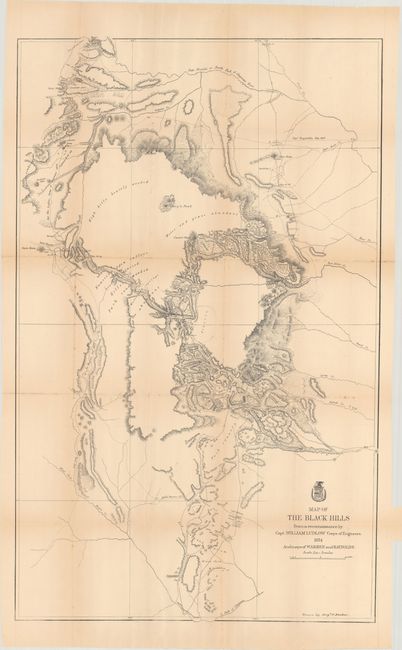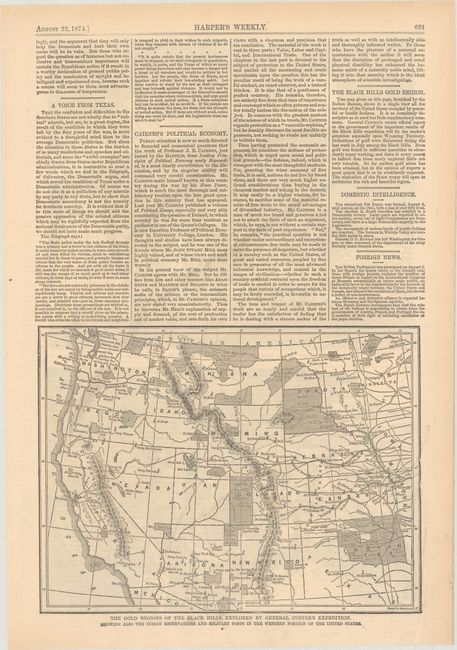Subject: Black Hills, South Dakota
Period: 1874 (dated)
Publication:
Color:
A nice set of three matched maps from Ludlow's report detailing Custer's Expedition into the Black Hills and a newspaper account with map:
A. A Geological Map of the Black Hills by Professor N.H. Winchell to Accompany the Report of Capt. William Ludlow U.S. Engineers, by U.S. Corps of Engineers, printed color (17.6 x 25.1"). In the summer of 1874, Custer was tasked with reconnoitering a route to Bear Butte and exploring the vicinity. Gold was discovered, leading to a major Gold Rush and an intrusion of white prospectors into the Black Hills, which are sacred to the Sioux and Cheyenne. This led to the Battle of Little Bighorn in 1876, and thus to the end for Custer and the 7th Cavalry. A legend in the lower left indicates eleven geological types through coloring and line. This map locates numerous creeks and gives detail of timber and topography. Condition: Issued folding with light toning and color offsetting. (B+)
B. Map of a Reconnaissance of the Black Hills, July and August, 1874, with Troops Under Command of Lt. Col. G.A. Custer, 7th Cavalry..., by U.S. Corps of Engineers, black & white (21.3 x 25.5"). This is Ludlow's principle map that shows the entirety of Custer's reconnaissance of 1874. The map extends from Old Ft. Pierre on the Missouri River to the Little Missouri Buttes and north to the Badlands and the Yellowstone River. The map traces Custer's route through the region of the Black Hills with the date of each encampment. It contains many interesting notations, such as "Where they killed the Rees," "Where the sickman was killed" plus many comments on water, grasslands, springs, etc. The topography is nicely developed and portions of Raynold's 1859 route is shown. Condition: Issued folding with light toning, minor foxing, and a couple of short splits at the fold junctions. (B+)
C. Map of the Black Hills..., by U.S. Corps of Engineers, black & white (23.6 x 38.3"). A large map drawn by Sergeant C. Becker with additional geography from the maps of Warren and Raynolds. It covers the Black Hills between the Belle Fourche or North Fork of the Cheyenne River to the South Fork of the Cheyenne. Drawn on a scale of 3 miles=1 inch. Topography is nicely developed with portions of Warren's route of 1857 and that of Raynold's in 1859 shown. Condition: Issued folding with light toning, minor foxing, and a couple of short splits at the fold junctions. (B+)
D. The Gold Regions of the Black Hills, Explored by General Custer's Expedition. Showing Also the Indian Reservations and Military Posts in the Western Portion of the United States, by Russel & Struthers, from Harper's Weekly, black & white (9.2 x 6.9"). This page from the August 22, 1874 issue of Harper's Weekly includes a map showing Indian Reservations in the West and contains a brief notice of the gold discovered during the expedition. The article states that "gold was found in sufficient quantities to abundantly repay working" and that the "expiration of the Sioux treaty will open to settlement this rich and beautiful region." Condition: Minor creasing and a hint of toning along the sheet edges. (A)
References: Wheat (TMW) #1248, #1249 & #1251.
Condition:
See description above.





